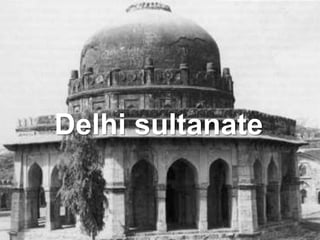suvo-delhisultanate-190802180537.pdf
- 2. Presented By SOUROV SHAHA SUVO ID: 20305
- 4. What is Delhi sultanate? Delhi sultanate were the Persian-speaking dynasties of Turkic and Afghan origin, which were controlling India from 1210 to 1526 Many of these dynasties ruled from Delhi The dynasties were Mamluk dynasty (1206-90) Khilji dynasty (1290-1320) Tughlaq dynasty (1320-1413) Sayyid dynasty (1414-51) Lodi dynasty (1451-1526)
- 5. The rise of Delhi sultanate Qutb-Ud-Din Aibek a former slave was the first sultan of Delhi and later his dynasties captured a large area of northern india Khilji dynasties was also able to conquer most most of central india The sultanate took several steps to defeat Mughal Empire Introduced indo Muslim cultures resulting education, literature, music, and poetry Delhi sultanate was the first only empire where female rulers ruled --- Razia Sultana (1236-1240)
- 6. Dynasties of Delhi sultanate Delhi sultanate Mamluk Dynasty From 1206 Till 1290 Khilji Dynasty From 1290 till 1320 Tughlaq Dynasty From 1320 Till 1414 Sayyid Dynasty From 1414 Till 1451 Lodi Dynasty From 1451 Till 1526
- 7. Dynasties of Delhi sultanate
- 8. Mamluk dynasty The dynasty was founded by Muhammad Ghori Area: Ghaznavids from southern to as far as Lahore, Rajsthan and the Punjab Rulers: Qutb-Ud-Din Aibek Successor Aramshah Ittutmish (Subedor of Badaun, son in law of Aramshah) Razia Sultana (Daughter of Iltutmish)
- 9. Mamluk dynasty The qutub Minar
- 10. Khilji dynasty The term Khilji was their-designation, meaning in Turkic languages "swordsman". Although they had played a conspicuous role in the success of Turkic armies in India, they had always been locked down upon by the leading Turks, the dominant group during the Slave dynasty.
- 11. Jalauddin Khilji: 1290-1296 AD Jalal uddin Khilji founded Khilji dynasty He followed mild and generous policies This generous policy of the Sultan affected his foreign policy. In 1290, he invaded the fort of Ranthambhor. In 1294, Ala-uddin nephew of Jalal-uddin, invaded Ramchandra, the ruler of Devagiri in the south.
- 12. Alauddin Khilji: 1296-1316 AD He was a nephew and son-in-law of Jalaluddin Khilji. Alauddin Khilji killed him and succeeded the throne in 1296. He was the first Turkish Sultan of Delhi who seperated religion from politics. The most important experiment undertaken by the Alauddin was the attempt to control the markets.
- 13. Khusro Khan: 1320 AD Khusrau Khan was killed by Ghazni Khan. This marked the need of the Khilji dynasty and the rise of Tughlaq dynasty at the throne of Delhi.
- 14. Tughlaq dynasty
- 15. Tughlaq dynasty Tughlaq Dynasty was basically of Turkish origin and the family religion was Muslim. In the year 1321, Ghazi Tughlaq succeeded the throne and was given the title as Ghiyath al-Din Tughlaq.
- 16. Ghiyasuddin Tughlaq (1320-1325 AD) Khusrau Khan, the last king of the Khilji dynasty was killed by Ghazni Malik, and Ghazni Malik ascended the throne assuming the title Ghiyasuddin Tughlaq. He died in an accident and his son (Ulugh Khan) succeeded him under the title Mohammad-bin-Tughlaq.
- 17. Mohammad-bin Tughlaq (1325- 1351 AD) Prince Jauna, Son of Ghiyasuddin Tughlaq ascended the throne in 1325 He tried to introduce many administrative reforms. He died while campaigning in Sindh against Taghi, a Turkish slave.
- 18. Firoz Shah Tughlaq(1351-1388 AD) He was a cousin of Mohammad-bin-Tughlaq. Established of Diwan-i-Khairat department for poor and needy people and Diwan Bundagan (department of slaves) Making Iqtadari system hereditary. The Tughlaq dynasty would not survive much after Firoz Shah's death. The Malwa, Gujarat and Sharqi (Kingdoms broke away from the Sultanate.
- 19. Sayyid dynasty
- 20. Sayyid dynasty Khizr-Khan , a lieutenant of Timur, was a Sayyid and so his dynasty is called Sayyid Dynasty. Khizr Khan (1414-1421):Timur's nominee captured Delhi and was proclaimed the new Sultan and the first of the Sayyid Dynasty. They ruled over Delhi and surroundings districts. Mubarak Shah (1421-1434):He succeeded Khizr at the throne after his successful expeditions against Mewatis, Katehars and the Gangetic Doab area. He was killed by the nobles in his own court. Alam Shah (1443-1451):The last Sayyid king descended in favour of Bahlol Lodhi and himself retired. Thus began the Lodhi dynasty, which confined to Delhi and a few surrounding areas.
- 21. Lodi dynasty
- 22. Lodi dynasty Buhlul Lodi established the Lodhi Dynasty and he ruled from 1451-1526. He was previously the governor of Sarhind (in Punjab), under the Sultan of Delhi Buhlul Lodi first occupied the province of Punjab and later on, captured Delhi and became the Sultan of Delhi on April 19, 1451 under the title of Sultan Abul Muzzaffar Buhlul Shah Ghazi.
- 23. Economic Conditions during Delhi Sultanate Agriculture: Agriculture was a major occupation at that time. Land was the source of production. Produce was generally sufficient. The village was a self-sufficient unit. Industries: There were village and cottage industries. The labour employed was the family members; the technique was conservative. There were industries of sugar, scents and spirits. Trade and Commerce Inland and foreign trade flourished. As for the internal trade we had the various classes of merchants and shop-keepers. Tax system The Sultan of the Delhi Sultanate collected five categories of taxes which fall under the economic system of the empire
- 24. Downfall of Delhi Sultanate Inherent weakness Absence of strong rules Unenlightened policy of the Govt. Absence of popular support Invasion of Tamer
- 25. Conclusion Above we had learned that Delhi based sultanates, mostly of Turkic & Afghan origin in medieval India . The sultanates ruled from Delhi between 1206 – 1526, when the last was replaced by the Mughal dynasty.

























